16 Essential Q&As on Nutrition Fundamentals: Macros, Vitamins, Hormones and More
- Milsner Fitness

- Aug 24
- 10 min read
Earlier this month, I had to retake my Certified Nutrition Coach exam with the National Academy of Sports Medicine (NASM) to ensure I maintained my credential, originally earned in 2022. Part of the recertification process is retaking the exam, so during my studying, I thought why not share this as an opportunity to test your knowledge on some relevant nutrition topics that manifest regularly in your daily life as well as those that come up in client conversations MOST often! I created 16 polls and shared them over a week-long period on my Instagram stories for you to chime in, test your knowledge and at the minimum– learn something new to benefit your nutrition!
The results weren’t striking one way or another, there were several that a majority guessed correctly as well as several that stumped you! The best part is that these are all topics that may come up in your life at one point or another, so I wanted to expand a bit deeper for you on why these are the right answers. If you're wanting more nutrition support, but don't know where to start & feel like you've tried all the diets, programs, pills and powders, but can't seem to really build a sustainable, enjoyable relationship with healthy eating, then my Lifestyle Nutrition Guide is perfect for you-- more on that as we go!
Here’s a quick breakdown of the questions, the right answers, and why they matter in your everyday life!
Nutrition Fundamentals
Macronutrients vs. Micronutrients
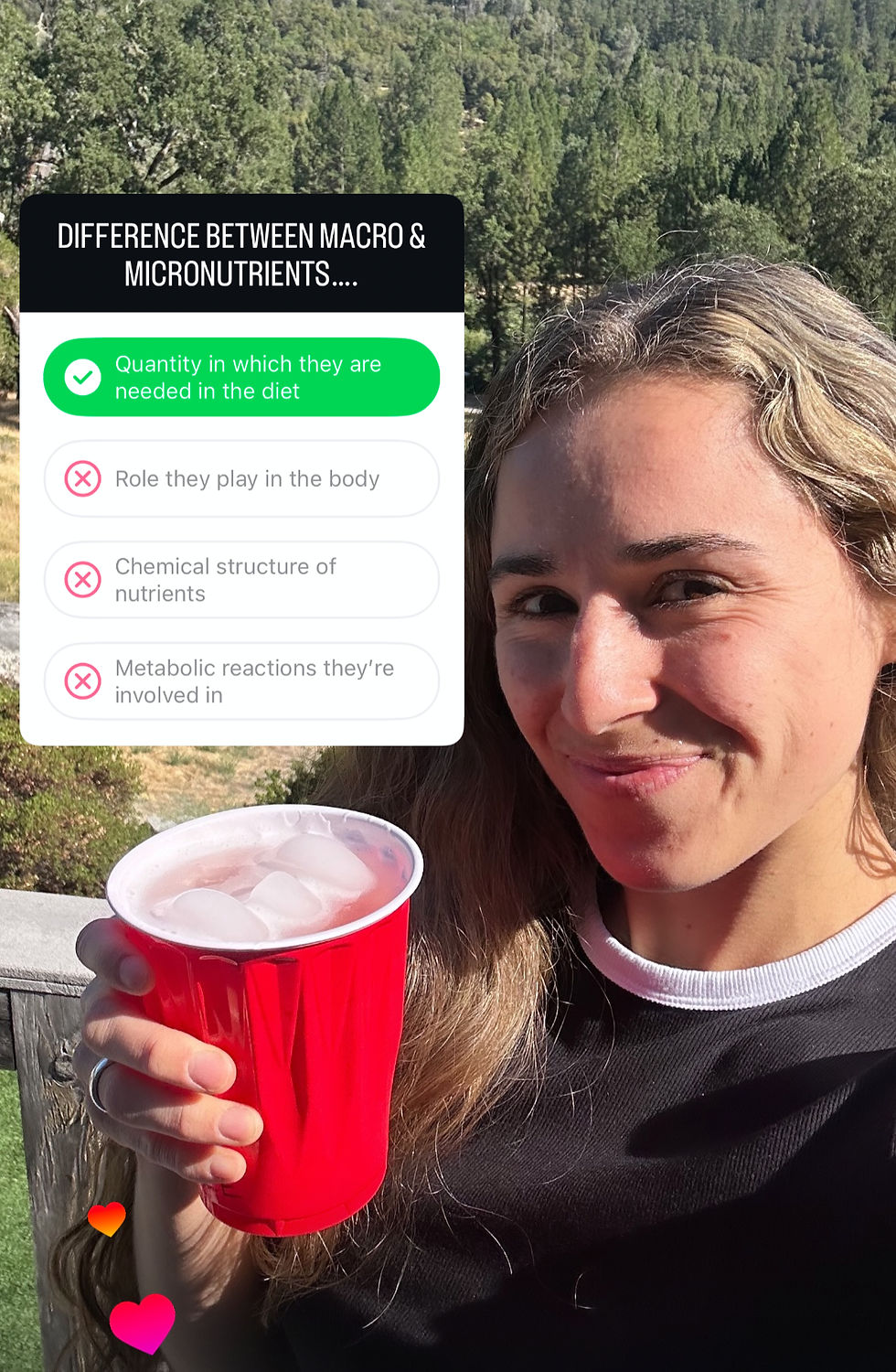
Question: What’s the difference between macro & micronutrients?
Answer: The quantity in which they are needed in the diet
Why this is correct: Macronutrients (protein, carbs, fat) are needed by the body in larger amounts for energy and all bodily functions. Micronutrients (vitamins and minerals) are required in smaller amounts, though are vital to supporting millions of bodily functions and organs in running smoothing and efficiency.
Coaching Tip: Your macros are going to be your more obvious components to each of your meals, while your micronutrients are going to come specifically from your food choices. Focus on prioritizing lean meats, fatty fish, fruits, vegetables, legumes and whole grains in a weekly nutritional regiment to optimize intake of micronutrients!
Fat-Soluble Vitamins

Question: Which vitamins are fat-soluble? Answer: A, D, E, K
Why this is correct: You’ll never forget this little acronym now! These vitamins are stored in fats, specifically in the liver and fatty tissues.
Coaching Tip: Aim to consume your ADEK rich foods with healthy fats during meals and snacks to absorb these nutrients — for example, when you’re ordering out, add a salmon protein (vitamin D + healthy fats) with a green leafy salad (vitamin K) for optimal nutrient absorption!
Water-Soluble Vitamins in Excess
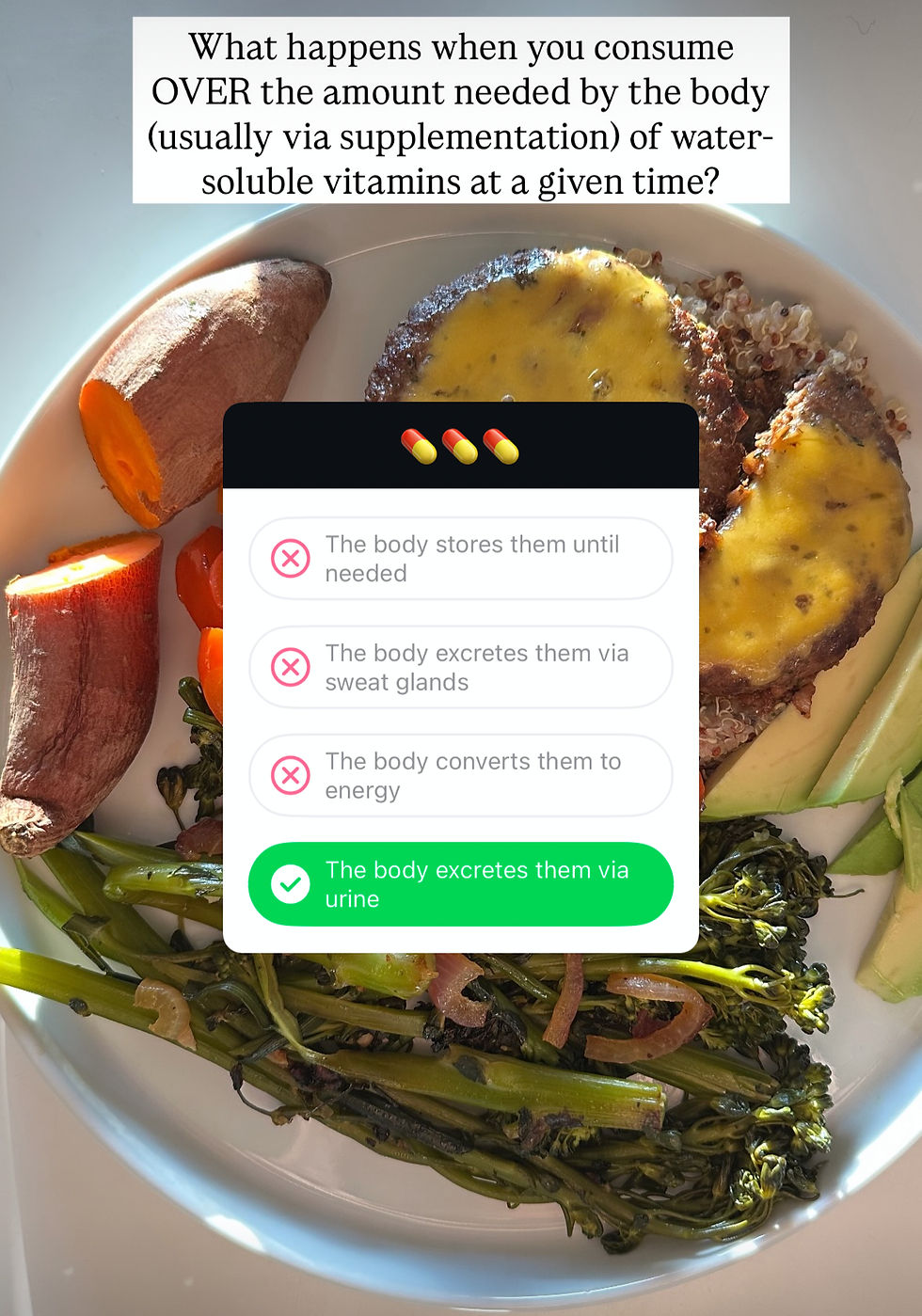
Question: What happens if you consume more water-soluble vitamins than your body needs?
Answer: They’re excreted in urine
Why this is correct: Unlike fat-soluble vitamins that are absorbed into the body and stored in adipose tissue, water-soluble ones (like Vitamin C and B vitamins) aren’t stored in large amounts and your body will naturally flush out what it doesn't need.
Coaching Tip: Have you ever noticed your pee being super yellow an hour or two after a meal and taking your supplements? This could raise a flag that you may be over consuming on certain nutrients and how I think about it–throwing money away! You’re buying it and your body is telling you no! I always recommend vitamin and nutrient intake from whole foods first, getting your labs drawn, and then talking with your doctor about single origin supplementation or a multi if that is warranted/recommended for you.
Nutrition Fundamentals: Macros
Protein Digestion Rate
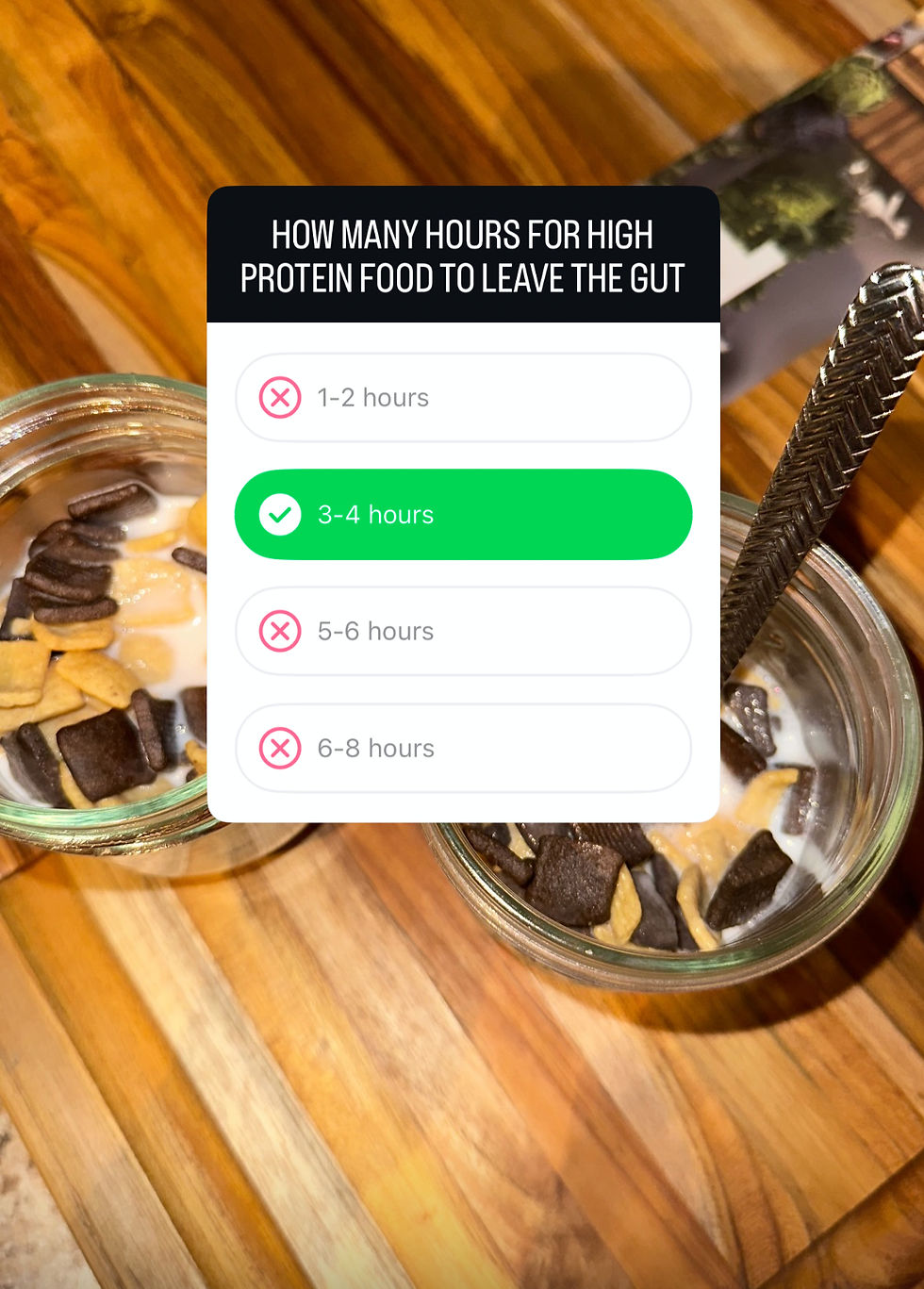
Question: How many hours does it take for high-protein food to leave the gut?
Answer: 3–4 hours
Why this is correct: In order of operations, carbs (simple, then complex) are the quickest to be digested and leave the gut, then protein, and lastly fats. Carbs are your body and brain's preferred and primary energy source and can be converted to energy super quickly. Protein and fats take a bit longer to digest, helping you stay fuller longer. Protein specifically provides steady amino acid release, maintaining optimal protein levels in the body for longer, supporting muscle repair and growth.
Coaching Tip: You already know to be getting in your protein, though if you struggle with hunger between meals, take a look to see how much protein you’re getting in each meal and snack. As a Nutrition Coach, I would constitute a meal as “high protein” if it consisted of 26g of protein or more, while I’d like to see meals closer to 30g!
Fat Digestion

Question: How long does it take fat-containing foods to leave the gut?
Answer: Up to 6 hours
Why this is correct: As detailed above, fat is the slowest macronutrient to digest, which is why high-fat meals can feel heavier as well as keep you full longer.
Coaching Tip: Pairing lean, healthy fats, with carbs and proteins during meals and snacks will help support your satiety and maximize absorption of fat soluble nutrients! Aim to avoid trans fats and limit saturated fats to 10% of your DV.
Protein & Muscle Protein Synthesis (MPS)

Question: Which protein amount & timing sustains MPS all day?
Answer: 21g per meal, 4 meals a day
Why this is correct: Studies have shown that spreading protein intake evenly throughout your day helps you maximize muscle repair and growth and the most optimal is with at least 21g of protein every 4 hours. You wouldn’t have the same impact on MPS by having coffee for breakfast, a 15g protein meal for lunch and 30g protein meal for lunch.
Coaching Tip: Again, consistency is key and if you can focus on getting a higher protein meal at each meal period (21–30g+ protein), you’re going to be supporting all your training efforts in the gym by optimizing muscle protein synthesis! Download my Lifestyle Nutrition Guide for easy meals that are perfect for meal prep and effortlessly optimize MPS!
Nutrition Fundamentals: Vitamins
Vitamin D Deficiency in the U.S.

Question: What % of the U.S. population has Vitamin D deficiency?
Answer: 7%
Why this is correct: Vitamin D gets a lot of attention, now more than ever with so many people working from home and having desk/computer based jobs. Though, just because you aren’t spending 2+ hours outside everyday as you may have as a kid, doesn’t mean you aren’t getting Vitamin D from other food sources, such as salmon, tuna, Shitake mushrooms and even fortified milks and cheeses.
Coaching Tip: While most people aren’t Vitamin D deficient, doesn’t mean it isn’t possible if you aren’t eating fatty fish and fortified dairy products on a weekly basis. Deficiencies can also happen as you age. I always recommend getting your labs tested (a full panel including all vitamins & micronutrients) at least once a year to see where a supplement (vitamin D or even omega-3s) may be supportive in your overall nutrition regimen. Another aspect to keep in mind is that labs vary when it comes to ranges, so always consult with your doctor if you’re changing labs year to year to ensure the true degree of change. One lab may say you’re in “normal range” while another could say, you're on the “upper end” of the range; remember, the numbers are important!
Vitamin K Function
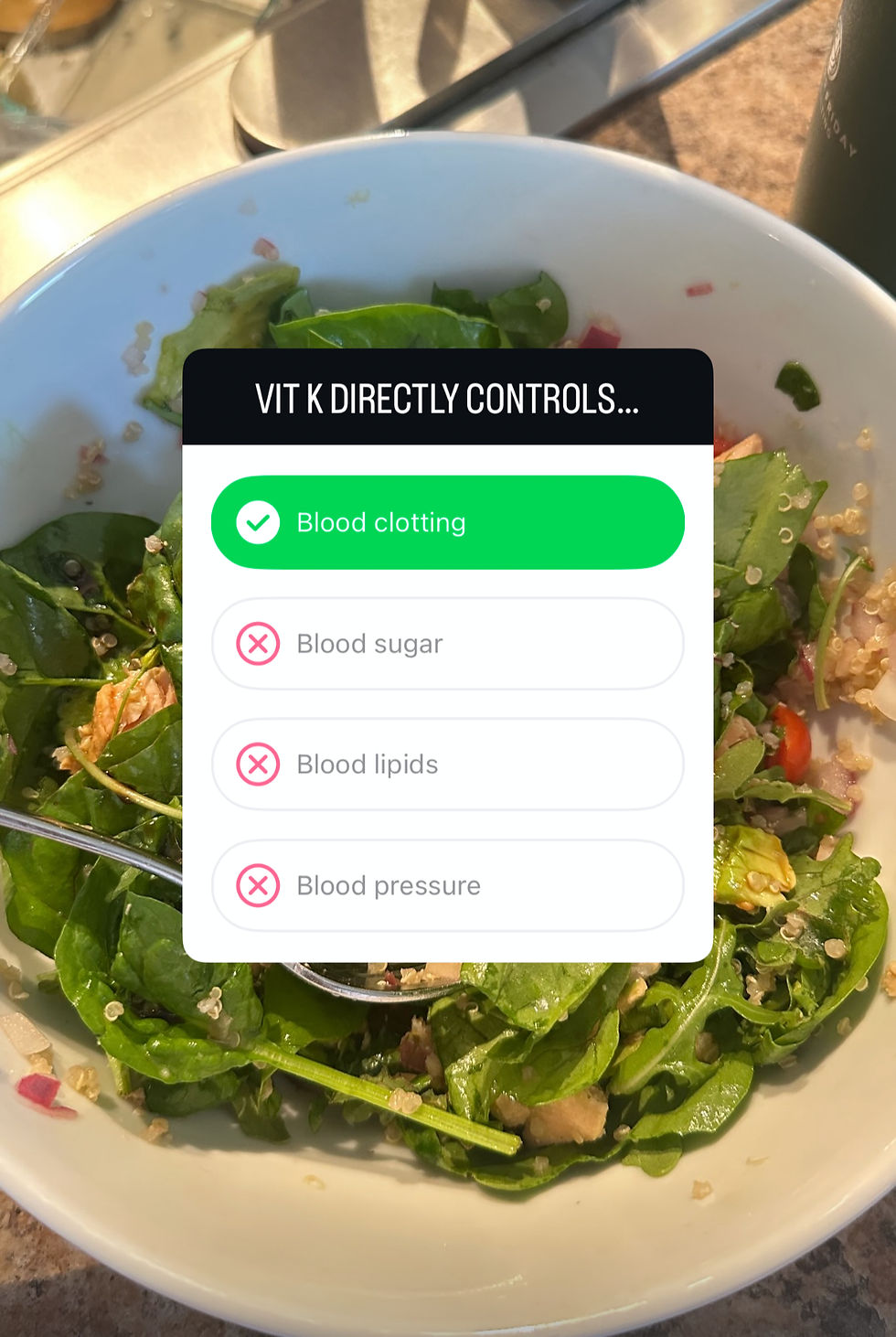
Question: What does Vitamin K directly control?
Answer: Blood clotting
Why this is correct: Vitamin K is actively involved in regulating blood homeostasis in the body by controlling clotting– so a pretty important vitamin I’d say! Luckily, getting in vitamin K is easy with a well balanced nutritional regimen.
Coaching Tip: When thinking how to get in more vitamin K or a good way to determine if you may not be getting in enough is if you are consuming dark, leafy greens like spinach, kale, parsley, Brussel sprouts, broccoli and even romaine, which are rich in Vitamin K. Aim to get in these foods several times a week, if not daily, to ensure you’re getting in enough vitamin K to support your blood health!
Vitamin K Sources & Solubility

Question: Vitamin K is found in which foods, and is it fat- or water-soluble?
Answer: Dark leafy greens, fat-soluble
Why this is correct: Vitamin K is a fat-soluble vitamin, meaning it needs dietary fat for absorption. You’ll always remember this by thinking “ADEK” which are your 4 fat soluble vitamins–the rest are water-soluble! Easy right? That’s why drizzling olive oil on your salad isn’t just tasty — it helps your body absorb nutrients.
Coaching Tip: This is why drizzling olive oil on your salad isn’t just tasty — it helps your body absorb vitamin K and other fat soluble vitamins. Pair your green leafy salads with avocado, nuts, or olive oil for maximum nutrient absorption.
Nutrition Fundamentals: Going Deeper
Fiber Intake in the U.S

Question: What is the current daily average fiber intake for men and women?
Answer: 18g for men, 15g for women (vs. recommended 38g and 25g)
Why this is correct: This is a hot take for so many of us as the industry and social media have really shifted a big focus on fiber in recent years, though it’s always been important! Most Americans eat less than half of the recommended daily fiber, creating an optimal marketing window for companies selling greens powders and pre/probiotics. Now, I am certainly not against these, however if you aren’t getting enough fiber to begin with, you can’t rely on supplementation to fix this. You have to address the root cause for the best results and changes.
Coaching Tip: First recommendation is to see how often and which type of fruits, vegetables, legumes and whole grains you’re consuming on a daily/weekly basis. I could do a whole lesson just on fiber, so I’d recommend starting there and ensuring you’re getting in one of those categories of foods at every meal, then let’s talk about the next layer! Simple swaps for unrefined grains such as white rice for brown rice and rice for quinoa every now and then, can make a big difference.
Recommended Daily Fiber Intake

Question: What’s the recommended daily fiber intake for women & men?
Answer: 25g (women) / 38g (men)
Why this is correct: What a huge disparity between how much fiber the average American is consuming daily vs. what is recommended right?!
Coaching Tip: This is why I am a big advocate of higher fiber meals and adding in fibrous foods into every single meal, because the average American is already deficient. My Lifestyle Nutrition Guide will support you with doing exactly this– download here!
Soluble vs. Insoluble Fiber
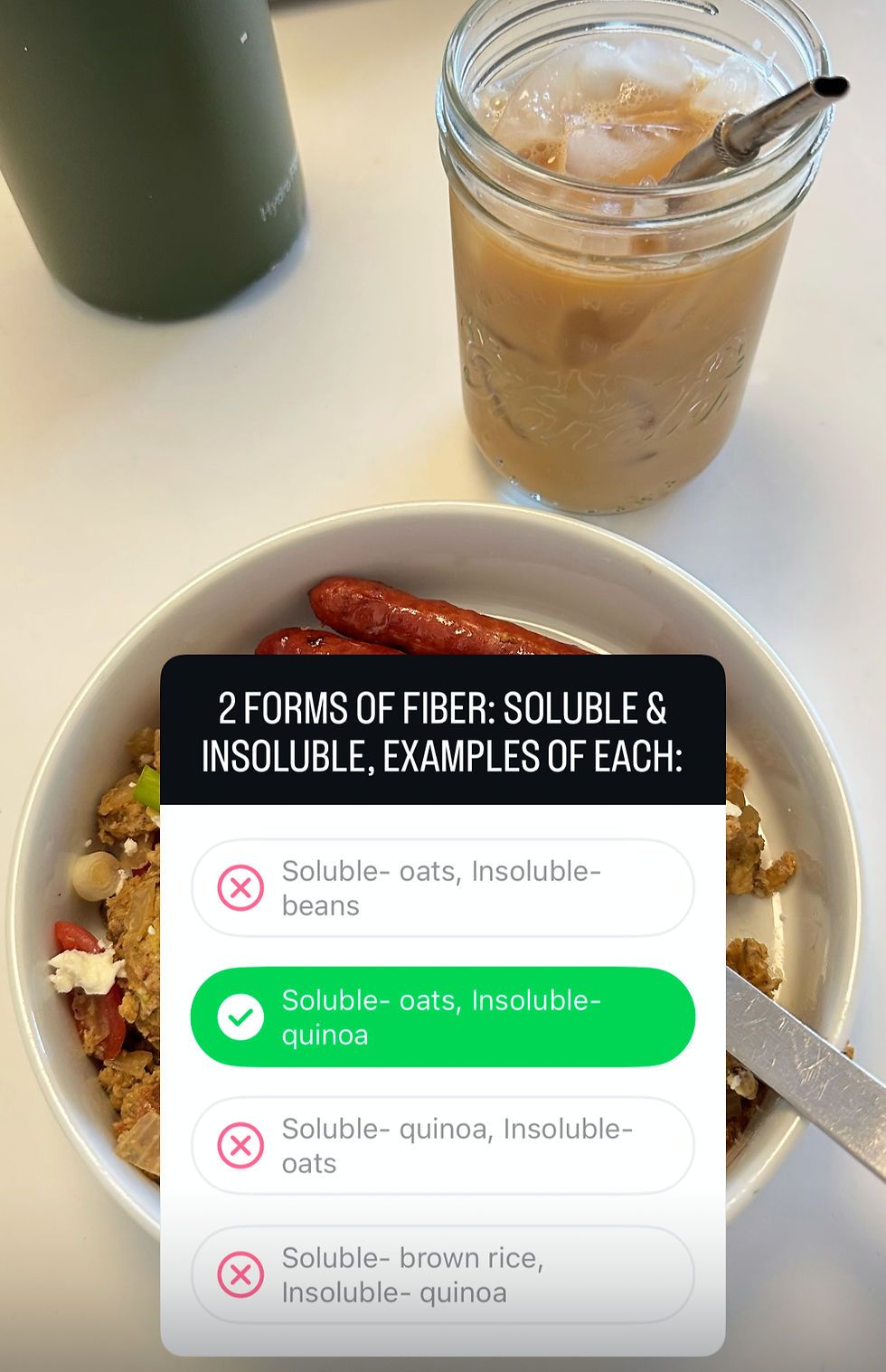
Question: Examples of each fiber type?
Answer: Soluble – oats; Insoluble – quinoa
Why this is correct: Definitely a tough one for many people! Soluble fiber dissolves in water to form a gel-like substance that slows digestion, which is great for blood sugar and removing cholesterol from the body. Insoluble fiber adds bulk to stool and supports regular bowl movements.
Coaching Tip: In a nutshell– you need two to tango, both soluble and insoluble fiber for optimal gut health and bowl movement regularity. Think oatmeal (soluble) for breakfast and a quinoa (insoluble) in your bowl for lunch or as a side at dinner. Would a handout on this be helpful for you? If so, download my Lifestyle Nutrition Guide and stick the fiber page to your fridge– it will be your fiber lifesaver!
Appetite Regulation Hormone

Question: Which hormone decreases appetite when released?
Answer: Leptin
Why this is correct: Leptin is your appetite suppressant hormone that is stored and secreted by fat cells, telling your brain when you’re full (satiated). You also of course have an appetite stimulator, a.k.a your hunger hormone– Ghrelin, which is released by the stomach and changes based on gender, age, & blood sugar.
Coaching Tip: Do you ever feel like you’re “not hungry” or on the contrary, “not full”? This could be a sign to work on hormone regulation by simply being more in tune with your body during meals. This could mean having meals undistracted, whenever possible, as well as using the 20 min rule with digestion– wait 20 mins before going back for 2nds or adding another helping to your plate to allow your body time to digest and your leptin and ghrelin hormones to kick in and tell you if you’re still hungry or if you’re actually full! If hunger is more of the signal you’re missing, try adding in small, high protein meals or snacks at meal times where you typically wouldn’t eat. Over time, this may support you in actually starting to sense and be more aware of those hormone signals.
Non-Exercise Activity Thermogenesis (NEAT)
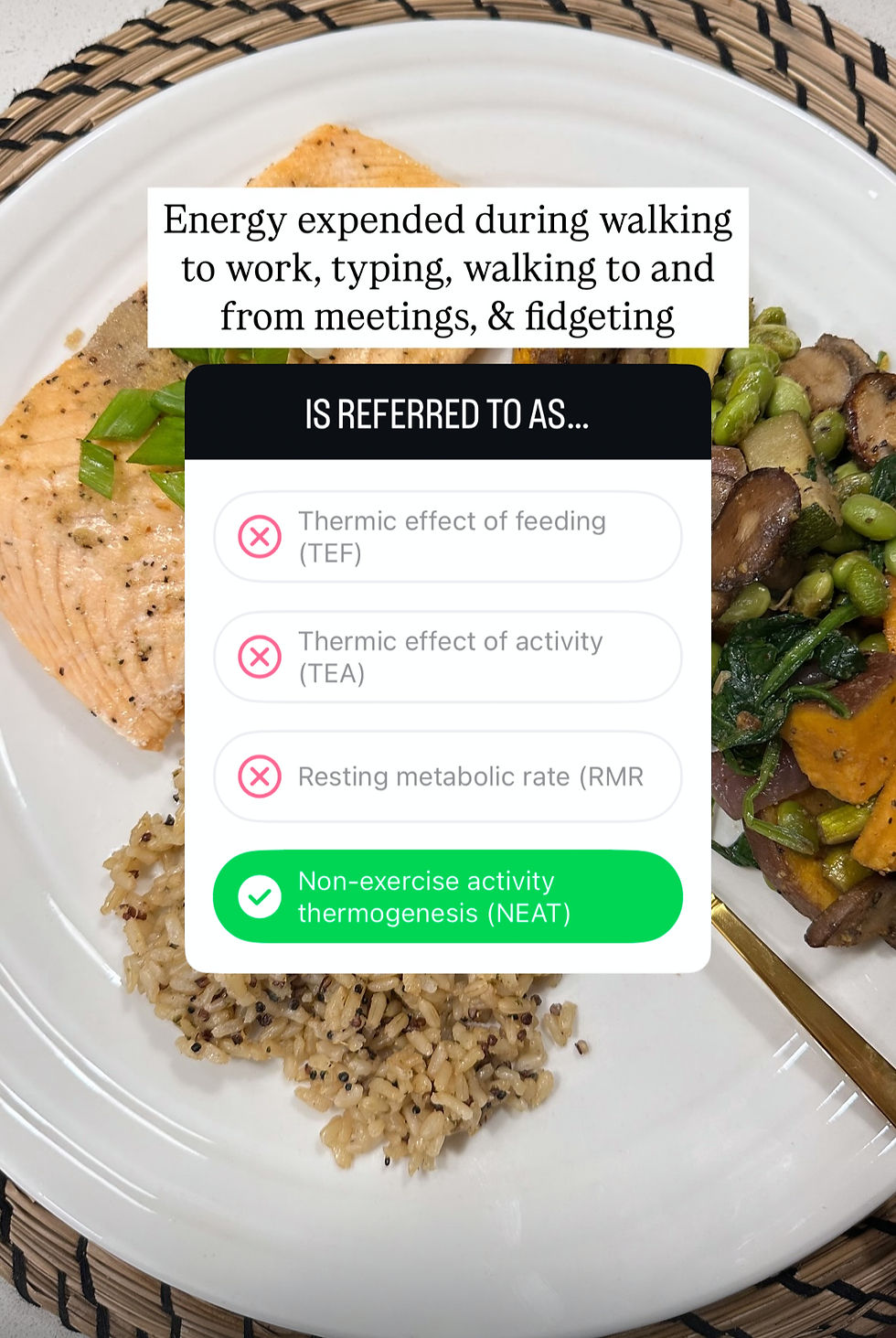
Question: Energy expended during walking to work, typing, walking to and from meetings, and even fidgeting is referred to as…
Answer: Non-exercise activity thermogenesis (NEAT)
Why this is correct: NEAT includes all the calories you burn when you’re not exercising, eating or sleeping.
Coaching Tip: Small shifts in your day to increase NEAT can include taking the stairs, using a standing desk at work, walking/pacing during calls, gardening, playing with your dog, or even simply parking further away from the store can all make a big difference on total calorie expenditure.
Nutrition Fundamentals: Facts You Never Knew
Thermic Effect of Feeding
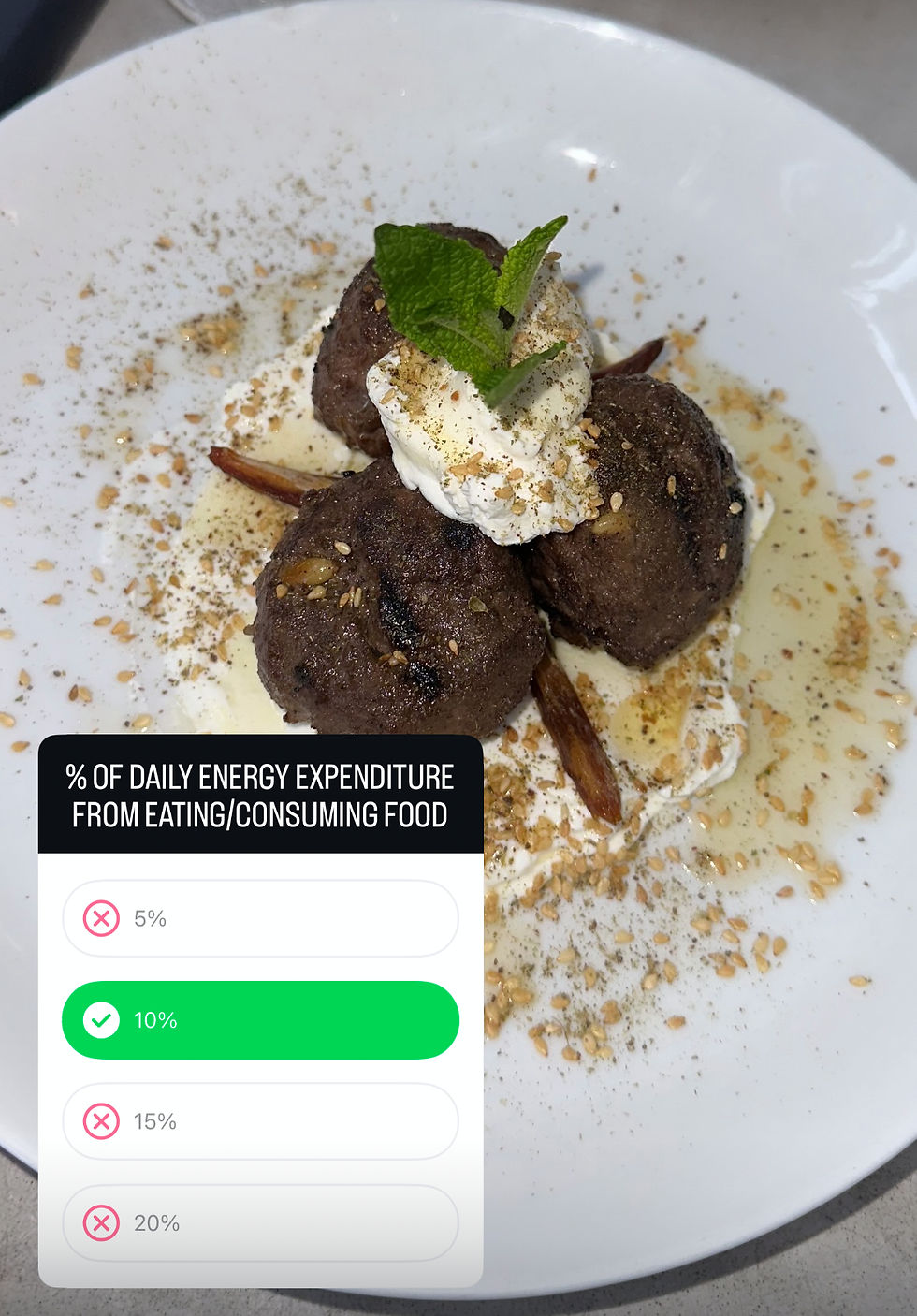
Question: What % of daily energy expenditure comes from eating/consuming food?
Answer: 10%
Why this is correct: This is known as the Thermic Effect of Feeding (TEF)-- yes you are actually burning calories while you are eating! Digesting, absorbing, and metabolizing food takes energy and accumulates to about 10% of your daily calorie burn.
Coaching Tip: Does this mean eating more often results in higher daily caloric expenditure? Not necessarily, this comes down to portion sizes and food choices.
Global Food Consumption Rise
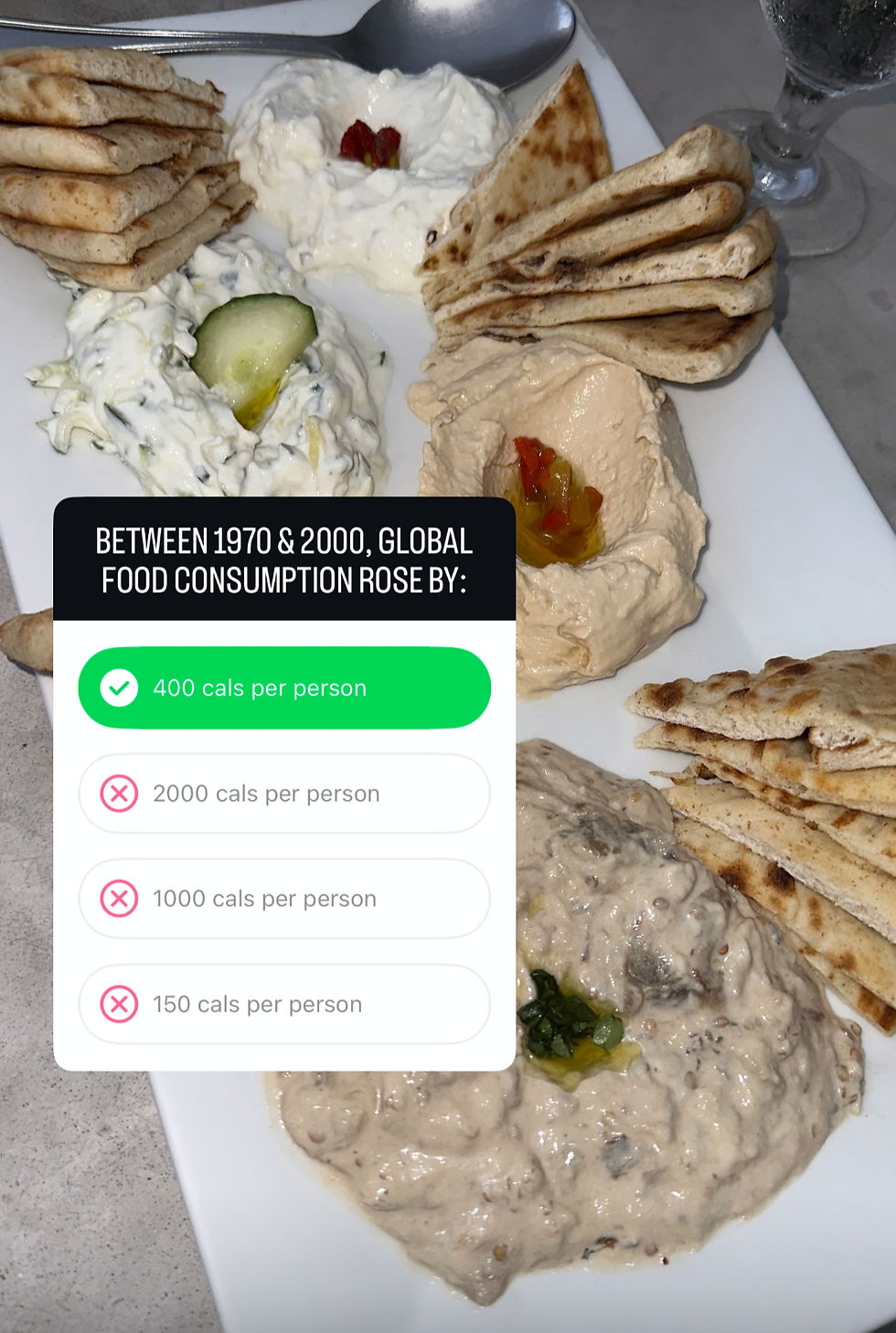
Question: Between 1970 & 2000, global food consumption rose by…
Answer: 400 calories per person
Why this is correct: This one was more of an interesting fact, also shedding light on rising obesity rates in recent decades.
Coaching Tip: Awareness is powerful — portion sizes and added snacks can creep up calorie intake without you noticing. Mindful eating helps balance this.
My hope for you is to make nutrition enjoyable and less stressful and overwhelming to understand and implement. The biggest recommendation I have for anyone seeking to build a healthier relationship with nutrition is to expand your nutrition education! The more you can learn about nutrition and how to apply this in your daily life, the better off you will be and the more enjoyment you will find in food!
There are so many pills, powders and programs out there that make all these wild claims to be able to get you the most insane results, that unfortunately end up being false promises. Why? Because you didn’t learn anything in the process or most importantly, how to maintain consistency and balance! This is key to any healthy lifestyle.
If you’re wanting to take the next step, slow baby steps, to truly learning nutrition fundamentals and how to implement those in your life for real change you can see and feel, start by downloading my Lifestyle Nutrition Guide and taking it one step at a time. Think of this guide as a book; you read a few pages each night– heck even each week– and apply something new you learned into that week ahead. You can take this guide as slow as you’d like, and I’d actually recommend it!
You know exactly where to reach me when you have questions or if you’re ready for the next step in your nutrition journey!








Comments